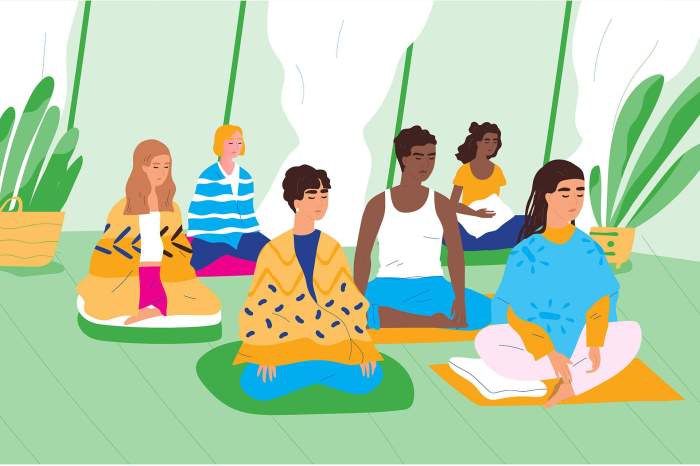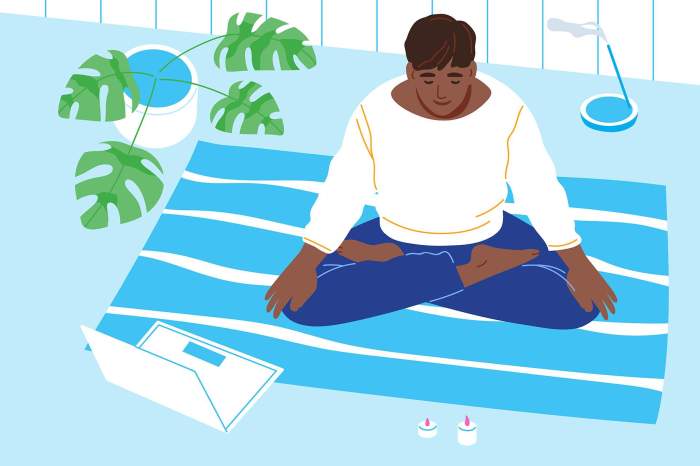Exploring the realm of guided meditation for anxiety, this introduction sets the stage for a journey towards tranquility and emotional well-being. Discover how this practice can offer relief and empowerment in the face of anxiety challenges.
Learn about the benefits, techniques, and tips that can transform your meditation experience and pave the way for a more serene mind.
Benefits of Guided Meditation for Anxiety

Source: mindful.org
Guided meditation can be a powerful tool in managing anxiety and its symptoms. By following a guided meditation session, individuals can experience a range of benefits that can help alleviate anxiety and promote overall well-being.
Improved Focus
- Guided meditation can help individuals improve their focus and concentration by directing their attention to the present moment.
- By practicing mindfulness during guided meditation, individuals can learn to let go of distracting thoughts and stay focused on the present, which can be particularly helpful in reducing anxiety symptoms.
Reduced Stress Levels
- Engaging in guided meditation can help reduce stress levels by promoting relaxation and calming the mind and body.
- Through deep breathing exercises and guided imagery, individuals can release tension and stress, leading to a more relaxed and peaceful state of mind.
Better Emotional Regulation
- Guided meditation can assist individuals in regulating their emotions by promoting self-awareness and emotional resilience.
- By practicing mindfulness and self-compassion during guided meditation, individuals can learn to respond to their emotions in a more balanced and constructive manner, reducing the impact of anxiety triggers.
Techniques Used in Guided Meditation for Anxiety
Guided meditation for anxiety often incorporates various techniques to help individuals manage their symptoms and find a sense of calm. These techniques can include deep breathing exercises, visualization, and body scans. Each of these methods plays a crucial role in promoting relaxation and reducing anxiety levels.
Deep Breathing
Deep breathing is a fundamental technique in guided meditation for anxiety. By focusing on slow, deep breaths, individuals can activate their body’s relaxation response and calm their nervous system. This technique helps in reducing the physical symptoms of anxiety, such as rapid heartbeat and shallow breathing.
Visualization
Visualization involves creating mental images of peaceful and calming scenes during guided meditation. By picturing oneself in a tranquil environment or engaging in soothing activities, individuals can shift their focus away from anxious thoughts and promote a sense of relaxation. Visualization can help in redirecting negative thought patterns and fostering a more positive mindset.
Body Scans
Body scans are another common technique used in guided meditation for anxiety. This practice involves bringing awareness to different parts of the body, starting from the toes and moving up to the head. By paying attention to physical sensations and releasing tension in each body part, individuals can release stress and promote a sense of relaxation. Body scans can help in grounding oneself in the present moment and fostering a deeper connection between the mind and body.
Creating a Safe Space for Guided Meditation

Source: mindful.org
When practicing guided meditation for anxiety, it is crucial to create a safe and comfortable environment that allows you to fully relax and focus on the practice. A calming space can help reduce distractions, alleviate stress, and enhance the overall effectiveness of the meditation session.
Setting Up a Calming Space
- Avoid noisy or high-traffic areas to minimize distractions.
- Choose a quiet room with soft lighting or natural light if possible.
- Consider using essential oils, candles, or incense to create a soothing aroma.
- Use comfortable cushions or mats to sit or lie down during the meditation.
Enhancing the Ambiance
- Play soft, calming music or nature sounds in the background to promote relaxation.
- Add plants or flowers to bring a sense of tranquility to the space.
- Adjust the temperature to ensure it is neither too hot nor too cold.
- Keep the space clutter-free and organized to create a sense of peace and serenity.
Finding the Right Guided Meditation for Anxiety
When it comes to choosing the right guided meditation for anxiety relief, it’s essential to consider the different types available and how they align with your specific needs and preferences.
Types of Guided Meditations for Anxiety Relief
- Mindfulness Meditation: Focuses on being present in the moment, observing thoughts and emotions without judgment.
- Body Scan Meditation: Involves systematically scanning your body for tension or discomfort and releasing it through deep breathing.
- Loving-Kindness Meditation: Cultivates feelings of compassion and kindness towards yourself and others, reducing anxiety and promoting emotional well-being.
Comparison of Meditation Apps and Online Resources
- Headspace: Offers a variety of guided meditations for anxiety, stress, and sleep, with user-friendly interfaces and structured programs.
- Calm: Provides guided meditations, sleep stories, breathing exercises, and music to help with anxiety and relaxation.
- Insight Timer: Offers a wide range of guided meditations from different teachers and practitioners, allowing for customization based on individual preferences.
Tips for Choosing the Most Suitable Guided Meditation
- Consider Your Preferences: Choose a guided meditation style that resonates with you and feels comfortable.
- Assess Your Needs: Identify specific anxiety symptoms or triggers you want to address through meditation.
- Try Different Options: Experiment with various guided meditations to find what works best for you.
- Seek Professional Guidance: Consult with a mental health professional or meditation instructor for personalized recommendations.
Final Conclusion
In conclusion, guided meditation for anxiety serves as a beacon of hope and resilience in navigating the complexities of mental health. Embrace the power of mindfulness and self-care as you embark on a transformative path towards inner peace and emotional balance.